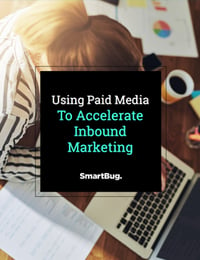
By Maia Milas
Navigating the relationship between paid media and AI can be complex, but luckily, there are ways to avoid getting lost in a sea of uncertainty. And because AI tools are evolving fast, keeping up with the latest advancements requires access to expert resources and insights.
In this episode of SmartBug On Tap, Paul Schmidt, VP of Marketing at SmartBug, and Louis-Claude Martin, a seasoned paid media expert at SmartBug, unpacked the real impact of AI on campaign strategy, targeting, and performance. From the power of first-party data to the evolving role of media managers, this episode reveals how to shift from manual guesswork to data-backed greatness in the age of AI. Let’s dive in!
Table of Contents
- Looking Back: Why Paid Media Used to Be Guesswork
- The Shift: How AI Is Transforming Paid Media
- Getting Strategic: What Still Demands a Human Touch
- Real Results: What Success Looks Like in the AI Era
- Looking Forward: What the Future Holds
- Parting Advice: Garbage In, Garbage Out
- Closing Thoughts: Don’t Just Automate—Accelerate
Looking Back: Why Paid Media Used to Be Guesswork
To start the vidcast, Paul asked about the biggest limitations of running paid media campaigns prior to the current maturity of AI tools.
Louis-Claude’s response recalled the manual nature of paid media efforts in the past, noting the amount of valuable time spent on tasks that required constant monitoring and tweaking, such as:
- Keyword research and targeting.
- Bid adjustments and budgeting.
- Audience segmentation.
- A/B testing and content optimization.
Previously, advertisers had to rely heavily on historical data and gut instinct to make optimizations, which often slowed down the pace of experimentation. For the most part, unless you had a massive team or budget, it was tough to personalize campaigns at scale.
The traditional process could be effective, of course, but it mostly came down to continuous trial and error. As a result, it was slow-going and left room for missed opportunities or overspending if you weren’t watching closely.
A New Way of Business
Now, with AI, marketers can test faster, optimize smarter, and spend more time on strategy and creative efforts—the things that actually drive performance.
Louis-Claude offered an example involving a franchise client in the home services space. Initially, their campaign strategy was built on what they claimed had “worked in the past.” They were targeting broad keywords such as “home renovation” and “contractors near me,” and splitting their budget evenly across regions based on population size. Unfortunately, some regions were eating up the budget but generating poor leads, and no one realized it for weeks.
Once AI-powered campaign tools were introduced, the platform automatically optimized toward high-converting zip codes and shifted the budget based on real-time lead quality. The results? Cost per lead dropped by more than 30 percent, and a few smaller markets were revealed to outperform the bigger ones—something that would likely be overlooked relying on gut instinct alone. It provides a perfect case for machine speed and learning outpacing human guesswork.
The Shift: How AI Is Transforming Paid Media
Paul’s next question centered on the most impactful ways AI is being used in paid media today. Louis-Claude listed these three game changers:
- Predictive modeling: Platforms can now anticipate which users are most likely to convert and automatically target them with the right message at the right time.
- Real-time bidding and budget allocation: AI shifts spend to the top-performing channels, campaigns, and even creative, sometimes minute by minute.
- Messaging optimization: AI tools can now test dozens of ad variations and learn what messaging or visuals resonate with each segment, at scale.
The benefit of offloading these tasks to AI? It frees team members up to focus on strategy, brand storytelling, and long-term growth—the parts of marketing that machines can’t do better than humans.
The Role of AI Tools Like Performance Max and Advantage+
Google’s Performance Max and Meta’s Advantage+ effectively automate audience targeting and ad placements based on the assets, goals, and audience signals you feed to the platform. The AI uses these insights to optimize across channels, finding conversions in places that most people don’t even think to look.
Instead of spending hours building detailed audience segments, the platform can test variations faster and find high-converting pockets of users more efficiently. However, Louis-Claude cautioned against putting blind trust in these automations. Trust the machine to assess performance, but humans need to give it the right inputs. Strategy becomes about feeding the AI strong creative assets, clear conversion goals, and the right data—then letting it run and guiding it as it learns.
Getting Strategic: Balancing AI with a Human Touch
According to Louis-Claude, AI is raising the bar for what’s possible with paid media in three primary areas:
- Campaign optimization: AI is constantly analyzing performance signals and making real-time adjustments—whether it's shifting budget to top-performing campaigns, adjusting bids by device or time of day, or pausing underperforming assets before we even notice.
- Targeting: AI is now identifying patterns in user behavior that we would never catch manually. It builds dynamic audiences based on intent signals, purchase cycles, and even content engagement, leading to more relevant impressions and better conversion rates.
- Creative development: AI helps us scale testing in a way that used to be impossible. Whether it's auto-generating variations of headlines, swapping images based on user profiles, or even using predictive models to suggest new angles.
What’s important to keep in mind is that the marketer’s role now is to guide the AI—feed it the right data, give it great creative assets, and competently interpret the performance signals it's sending. AI helps immensely, but it’s still not as in-touch as a human with a greater understanding of context, culture, creativity, and nuance.
AI is also still creatively limited, so Louis-Claude recommended that initial artistic endeavors, like first drafts, be composed by humans. However, he noted that AI is incredibly useful for multi-variant creative testing at scale, as it can generate dozens of creative combinations in seconds, launch them dynamically, and optimize based on performance in real time.
Louis-Claude also advised marketers to double down on what the machines can’t do, such as thinking creatively, building strategy, and understanding the why behind the data. We must be responsible for guiding AI, interpreting results, and turning those insights into smarter decisions.
Agentic AI’s Value
More HubSpot users are leveraging the platform’s agentic AI features to augment and strengthen decision-making. Later in the vidcast, Paul raised concerns about agents completely replacing campaign managers, but Louis-Claude doesn’t foresee an immediate threat:
“I don't think they're going to replace managers. They're just going to help us. They're going to do the repetitive tasks much better than a person could do. So in the end, [campaigns are] still going to need some direction from the managers, but [AI is] going to analyze data much quicker than we could.”
The Importance of First-Party Data and CRM Integration
So, what role does first-party data and CRM integration play in paid media automation with AI? Louis-Claude said these are two essential ingredients in AI-driven campaign success. In conjunction, they provide all the necessary data to the advertising platform so it can define and target customers more accurately.
Real Results: What Success Looks Like in the AI Era
Louis-Claude shared another example of AI-driven paid media making a measurable difference with a client in the banking industry, in which the AI was programmed to find the “extended audience” (basically finding potential customers that look like the bank clients). The cost per lead dropped by 66 percent, attributed to the targeting assisted by the AI.
He says one reason that the campaign worked so well was because his team fed the AI high-quality first-party data from the client’s CRM, which was integrated through HubSpot. That enabled the AI to go beyond surface-level lookalikes and actually target people who resembled the bank’s best clients. His team was also able to track that lead quality through the funnel, so they weren’t just optimizing for cheap clicks but for real results.
He elaborates:
“The AI is only going to be as good as the prompt [you] give it. So the more context, the more data you give it, the better results you're going to get. But don't get me wrong—AI is a huge revolution as far as I'm concerned. It's probably the biggest revolution in the history of the world. Not only in advertising, but at large.”
Looking Forward: What the Future Holds
In the short term, Louis-Claude sees AI continuing to reduce the heavy lifting previously required of paid campaign managers. Once again, the adoption of AI tools will allow managers more time to strategize at a higher level, as tedious tasks, such as testing different ad variations, are offloaded to AI.
What will separate great marketers from the rest is their ability to guide the AI with better data, enhanced strategies, and a deeper understanding of customer psychology. The marketers who thrive will be the ones who know how to lead the agents, not just launch them, and the real magic will come from combining human insight with machine execution.
In terms of skills necessary for marketers looking to succeed in the AI era, Louis-Claude lists the following key competencies:
- Strategic and analytical thinking
- Data interpretation
- Creative direction and judgment
- Ability to collaborate
He also adds that marketing leaders should be investing in three key areas to stay ahead of the curve:
- Data infrastructure: Strong CRM integration, clear tracking, and a solid measurement framework
- Talent development: Upskilling teams in strategy, analytics, and creative thinking
- Flexible tech stacks: Tools that can evolve and enable your organization to pivot quickly
Parting Advice: Garbage In, Garbage Out
Paul’s final question asked for one piece of advice that Louis-Claude would give to marketers looking to improve their paid media strategy with AI. He stressed that, apart from clarity in your campaign goals, you must align those goals with strong first-party data. Without clean, connected, meaningful data, even the most advanced AI can’t optimize effectively. He compared it to giving a GPS bad coordinates—you won’t get where you want to go.
Closing Thoughts: Don’t Just Automate—Accelerate
The biggest takeaway here is that AI is changing the game, but it’s not replacing strategy—it’s amplifying the marketers who know how to guide it. Throughout the vidcast, Louis-Claude mentioned the importance of clean data and capable human oversight in AI adoption. These two elements are essential when implementing an AI-driven strategy. Blindly relying on the intelligence of an AI tool leveraging subpar data (or, as Louis-Claude calls it, “firing and forgetting”) is a recipe for underperformance.
Thanks for joining us for another episode of SmartBug on Tap. If you’re looking for further guidance on AI and other technology services, turn to SmartBug’s deep expertise in custom AI solutions.
About the author
Maia Milas "You can always edit a bad page. You can't edit a blank page." -Jodi Picoult Read more articles by Maia Milas.









